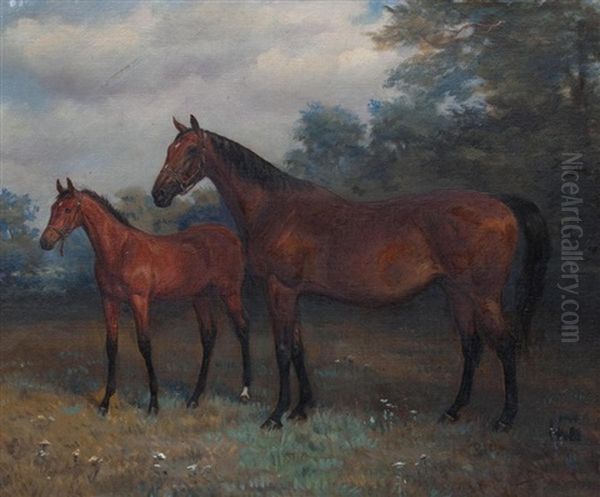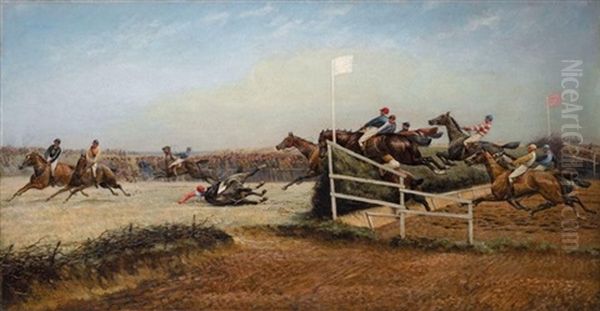Geoffrey Douglas Giles stands as a notable figure in British art, particularly celebrated for his vivid depictions of military life, sporting pursuits, and equestrian subjects. Active during the late Victorian and Edwardian periods, his work captures the spirit of an era marked by imperial confidence, a deep-seated love for country sports, and a romantic appreciation for the martial and the pastoral. His journey from a naval officer to a respected artist, trained in the prestigious ateliers of Paris, provides a fascinating narrative of dedication and a keen observational eye.
Early Life and Naval Service: Foundations of an Artist
Born on November 9, 1857, in Karachi, which was then part of British India, Geoffrey Douglas Giles was immersed from a young age in the visual tapestry of colonial life and the ever-present British military. His British parentage and upbringing within the Empire undoubtedly shaped his early perspectives and thematic interests. The vibrant colours, diverse cultures, and the structured environment of British India would have provided a rich sensory backdrop to his formative years.
His early career path, however, was not immediately directed towards the arts. Giles chose a life at sea, joining the Royal Navy. This period of service, though not his ultimate calling, was far from wasted. The discipline, attention to detail, and exposure to diverse landscapes and maritime scenes inherent in naval life would have honed his observational skills. Furthermore, experiences of camaraderie, hierarchy, and the mechanics of naval operations might have subtly informed his later depictions of organised human activity, whether in military formations or coordinated hunting parties. The decision to eventually leave the Royal Navy in 1884 marked a significant turning point, redirecting his energies towards a passion that had perhaps been simmering beneath the surface.
The Parisian Sojourn: Honing Skills with Carolus-Duran
Upon leaving the navy, Giles made the pivotal decision to pursue formal art training in Paris, the undisputed epicentre of the art world in the late 19th century. He sought out the tutelage of Charles Auguste Émile Durand, famously known as Carolus-Duran. This was a significant choice, as Carolus-Duran was not only a highly successful society portraitist but also an influential teacher whose atelier attracted aspiring artists from across Europe and America.

Carolus-Duran (1837-1917) was known for his emphasis on direct painting (alla prima), encouraging students to capture the essence of their subject with bold brushwork and a keen sense of tonal values, somewhat influenced by the techniques of Velázquez. He advocated for painting what one saw, rather than adhering strictly to academic formulas, though his own work retained a strong sense of structure and elegance. Studying under such a master provided Giles with a robust technical foundation. Other notable artists who benefited from Carolus-Duran's instruction include the celebrated American expatriate John Singer Sargent, whose dazzling brushwork and psychological insight set new standards for portraiture. The environment in Paris, bustling with artistic debate and innovation, from the established Salon to the emerging Impressionist and Post-Impressionist movements, would have been incredibly stimulating for Giles.
Artistic Style and Thematic Concerns
Geoffrey Douglas Giles developed a style characterized by its realism, dynamism, and meticulous attention to detail, particularly in the rendering of horses, military uniforms, and the nuances of sporting action. His work generally aligned with the narrative and illustrative traditions popular in Victorian and Edwardian Britain, appealing to a public that appreciated clear storytelling and technical proficiency.
His primary thematic concerns revolved around military subjects and sporting scenes. Military paintings often depicted cavalry charges, regimental life, and historical battles, reflecting Britain's imperial engagements and the public's fascination with military heroism. These works were not merely illustrative but sought to convey the drama, energy, and sometimes the pathos of warfare. His naval background, though not his primary artistic subject, may have given him an intrinsic understanding of service life and discipline, which translated well into his military portrayals.
Sporting art, particularly equestrian subjects, formed another cornerstone of his oeuvre. Fox hunting, game shooting, and horse racing were popular pastimes among the British gentry, and Giles captured these activities with an insider's knowledge and an artist's eye. His ability to depict horses in motion – their anatomy, musculature, and spirit – was particularly admired. He understood the bond between rider and horse, and the specific rituals and landscapes associated with British country sports. Artists like George Stubbs (1724-1806) had laid the groundwork for British animal and sporting painting, and Giles continued this tradition, albeit with the stylistic sensibilities of his own era.
Representative Works: Capturing Action and Atmosphere
Several works stand out in Geoffrey Douglas Giles's artistic output, showcasing his skill and thematic preferences. While a comprehensive catalogue is extensive, certain pieces are frequently cited.

One such example is "Wild Boar & her Young in a Landscape & Pursuit of a Wild Boar." This title suggests a dynamic composition, likely featuring the thrill of the chase. One can imagine a scene rich with natural detail – the dense undergrowth of a forest, the powerful forms of the boars, and the determined energy of hounds and mounted hunters. Such a painting would appeal to those who appreciated both the beauty of the natural world and the excitement of the hunt, a popular theme also explored by artists like Sir Edwin Landseer (1802-1873), though Landseer often imbued his animal subjects with more overt sentimentality.
Another notable work is "St Windeline & Wool Winder," dated 1904. The title is intriguing. St. Wendelin (or Windeline) is a patron saint of shepherds and country folk. This suggests a departure from purely sporting or military themes, perhaps venturing into a more pastoral or even subtly allegorical scene. A "wool winder" implies a domestic or rural craft. The combination could depict a serene countryside scene, possibly with sheep, imbued with a sense of rustic piety or tradition. This work, measuring 12 x 14 inches, indicates his versatility in handling different scales and subjects. The detailed inscription and signature point to a finished piece intended for exhibition or sale.
Paintings simply titled "Shooting Scene" also feature in his body of work. These would typically depict gentlemen with shotguns, often accompanied by gundogs, in pursuit of game birds like pheasant or grouse. Such scenes allowed Giles to showcase his skill in rendering figures in a landscape, the textures of tweed and leather, and the alert stances of dogs. Contemporaries like Archibald Thorburn (1860-1935) specialized in wildlife, particularly birds, with incredible accuracy, and while Giles's focus was broader, his sporting scenes would have shared a similar appreciation for the British countryside and its fauna.
His military paintings, though less specifically titled in the provided information, would have captured the pageantry and action of the British army, particularly cavalry units. These would have resonated with a public proud of the Empire and its military traditions. Artists like Lady Butler (Elizabeth Thompson) (1846-1933) were renowned for their powerful and often poignant depictions of British soldiers, and Giles's work would have contributed to this popular genre. Richard Caton Woodville Jr. (1856-1927) was another contemporary known for his dramatic war illustrations and paintings, often depicting scenes from colonial conflicts.
Exhibitions, Recognition, and Later Career
Giles achieved considerable recognition during his lifetime. He exhibited extensively, most notably at the Royal Academy of Arts in London, which was the premier venue for artists seeking to establish their reputations. Between 1884 and 1904, he showed at least seventeen works there, a testament to the consistent quality and appeal of his paintings. He also exhibited at the Royal Institute of Oil Painters and other prestigious galleries.
His work was not confined to exhibition walls; it also found its way into print, with some of his paintings being reproduced as engravings or illustrations, further broadening his reach. The fact that his works are held in collections such as the King's Royal Military Museum (likely referring to collections like the National Army Museum or regimental museums) and the "Royal Portfolio" (perhaps the Royal Collection) indicates the esteem in which his art was held.
His artistic career spanned several decades, from his debut in the 1880s through the early 20th century. He continued to paint with dedication, adapting to changing tastes while remaining true to his core strengths in realistic and narrative depiction. The art world was undergoing radical transformations during his career, with the rise of Impressionism, Post-Impressionism, Fauvism, and Cubism. While artists like Claude Monet (1840-1926) and Vincent van Gogh (1853-1890) were revolutionizing painting on the continent, and figures like Walter Sickert (1860-1942) were bringing a grittier, more modern sensibility to British art, Giles largely remained within the established academic and narrative traditions. This was not uncommon; many successful artists continued to cater to prevailing tastes for representational art.
The Broader Artistic Context
To fully appreciate Geoffrey Douglas Giles, it's helpful to place him within the wider context of late 19th and early 20th-century art. In Britain, the Royal Academy, under presidents like Lord Frederic Leighton (1830-1896) and Sir Edward Poynter (1836-1919), championed a form of classicism and highly finished narrative painting. Artists like Sir Lawrence Alma-Tadema (1836-1912) created meticulously detailed scenes of ancient Rome and Egypt that were immensely popular. While Giles's subject matter was different, the emphasis on technical skill and clear storytelling was shared.
In France, where Giles trained, the academic tradition was also powerful, with artists like Jean-Léon Gérôme (1824-1904) and William-Adolphe Bouguereau (1825-1905) producing highly polished historical and mythological scenes. Carolus-Duran, while part of this system, encouraged a more direct and painterly approach, which likely influenced Giles's own handling of paint.
The world of sporting art had its own lineage. Beyond Stubbs and Landseer, artists like John Frederick Herring Sr. (1795-1865) had specialized in equestrian portraits and racing scenes. Giles's contemporary, John Emms (1843-1912), was particularly known for his lively depictions of foxhounds and terriers, capturing their individual characters. Giles's work fits comfortably within this genre, valued for its accuracy and ability to evoke the atmosphere of the British sporting life.
Legacy and Conclusion
Geoffrey Douglas Giles passed away on February 1, 1941, in London, England. He left behind a significant body of work that serves as a valuable visual record of British military and sporting life during a transformative period in history. While he may not have been an avant-garde innovator in the vein of the Impressionists or Post-Impressionists, his contribution lies in his skillful and dedicated chronicling of the subjects he knew and loved.
His paintings offer a window into the values, pastimes, and aesthetics of Victorian and Edwardian Britain. They speak of a world where imperial power, rural traditions, and a certain code of conduct were paramount. For collectors and enthusiasts of military and sporting art, Giles's work remains highly regarded for its accuracy, dynamism, and artistic merit. His ability to capture the spirit of the horse, the drama of the battlefield, and the camaraderie of the hunt ensures his enduring appeal.
In the grand narrative of art history, Geoffrey Douglas Giles occupies a niche as a talented and respected specialist. His training under a notable Parisian master, his successful exhibition record at the Royal Academy, and the enduring appeal of his chosen subjects secure his place as a significant British painter of his generation. His art continues to be appreciated for its technical accomplishment and its evocative portrayal of a bygone era, offering insights into the cultural fabric of late 19th and early 20th-century Britain.